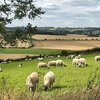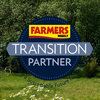Bar Tech October 2021
Welcome to the latest BarTech with thoughts, tops tips and advice from the UK Grass Experts on grass and herbal leys for livestock, arable and the environment.

Welcome to the latest BarTech with thoughts, tops tips and advice from the UK Grass Experts on grass and herbal leys for livestock, arable and the environment.


Pondering the return of livestock into an arable rotation...
Pondering the return of livestock into an arable rotation? Whether faced with problem weeds, as a move towards improving soil health, or part of a regenerative agricultural strategy, it’s a move many farmers are considering.
When it comes to grassland management, there are a lot of things to balance at this time of year such as prioritising the best allocation of forage for certain classes of stock, such as ewes destined for the tup, against leaving appropriate residuals for high quality spring swards.
Just as different species start to grow quicker than others in spring, so to do different species slow at different rates in autumn, as soil and air temperatures drop and day length and light intensity reduces. It is the low temperatures which are the most significant limiting factor to grass growth rate at this time of year. Generally, clovers, brassicas and perennial grass species, such as timothy and perennial ryegrass, slow down first, then hybrid and Italian ryegrasses. Westerwolds, which will grow to around 3-4oC, are the last to stop.
Managing establishing grass swards – when to graze?
An ‘establishing sward’ is one which is under 12 months old and, in an ideal world, would only be grazed during that time. For the recent summer reseeds and ones that are only a few weeks old, carrying out a ‘pluck test’, will show if a sward is ready to be grazed. Follow the guide on how to carry out a pluck test. If the leaves break off and the roots stay in the ground, the pluck test is passed, and the ley is ready to graze.
At this time of year it is particularly critical to make sure that the ground is firm enough to carry livestock, preventing poaching. Also, never graze a new sown ley before the grass plants have produced their second tiller. If the ground is firm and you add livestock, remember the first grazing is about managing the sward and encouraging tillering, not about feeding animals. Always pick the lightest stock class available and do not graze these vulnerable swards below 7cm at this time of year.
Earlier spring reseeds, which are now a few months old and have been previously grazed, will be better established and may cope with larger animals but should be treated with equal care and attention to encourage further tillering (especially if they have been cut rather than grazed). It is still vital to ensure the ground is firm enough to carry livestock.
Managing established grass swards
An established grass field is one which is at least 12 months old. Within the rotational grazing platform, thoughts will now turn to spring requirements. The first fields that will be grazed in spring should be the first to be rested in the winter. Due to the much slower growth rates, it can take a perennial ryegrass plant 1 month to produce a single new leaf during winter compared to 24 days for three new leaves in summer when growth rates are at their highest, so paddocks should be rested for at least 4 months during the winter period. Established paddocks should be grazed to around 1500kg DM/ha (~4cm) and no lower before resting. It is crucial to adhere to grazing residuals at the time of year both to avoid excess cover but also to avoid grazing too low and causing the plants to start to use up their carbohydrate reserves to be bale to produce new leaves. Grazing too low can affect persistency, reduce root mass and tillering and have a deleterious effect on subsequent yields.
Rotation lengths are likely to already have been increased, even to as much as 35 – 40 days by the beginning of October, to start to build up a little more cover before the final grazing cycle commences this month. In an average year, this will start in mid-late October carrying on into November with livestock then either being housed or moved to sacrifice fields, brassica swards or deferred grazing. Obviously, these timings will be influenced on geographical location and soil types as well as the weather.
On a cattle grazing platform, where excess growth occurs in a mild autumn and ground conditions haven’t allowed for mowing out a surplus paddock, sheep are an excellent tool for removing this surplus growth. This is crucial to prevent a build-up of low-quality, dead grass or diseased material for the spring sward when stock is returned to the rotational platform.
The same principle applies to silage ground, removing excess growth over the next couple of months will maintain a high quality sward for first cut. Again, livestock should be removed in December/early January or in plenty time to allow the sward to recover before first cut.
Plan for reseeding in 2022
Now is a great time to review the grass performance on your farm for the year 2021. Identify which, if any, of your fields could be considered poorly performing or underperforming, take soil samples to highlight soil fertility issues and check fields for soil structure problems. Create a plan to rectify any areas of lower fertility and productivity with an appropriate nutrient management plan and reseeding or overseeding in the spring time. The Barenbrug Good Grass Guide is a useful tool for keeping records of each field to help with this process and again, now is a great time to condition score your grass.
Your grass management plan now will depend on the ages of the sward, sown species, and livestock requirements as well as considering the requirements for spring 2022. Good grass management now can extend the grazing season and significantly improve grass utilisation, therefore allowing a reduction in winter feed and housing costs.
Brassica Crops
Brassica crops are widely utilised to supplement forage based diets when grass growth is limited and are a common option to extend the autumn and winter grazing season. Find out more here
Read our good grassland management guide to find out more


As a key member of the Farmers Weekly Transition Partner Network...
As a key member of the Farmers Weekly Transition Partner Network, Barenbrug UK is part of a selected, UK-wide community of farmers, industry stakeholders and influencers working together to secure a sustainable future for your farm business.
Discover our range of grass, forage, clover, herb and legume mixtures for the agriculture sector.
Discover our range of grass, forage, clover, herb and legume mixtures for the agriculture sector.
Discover our range of grass, forage, clover, herb and legume mixtures for the agriculture sector.